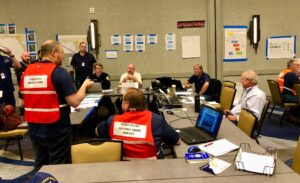Effective crisis communication entails coordination at an organisation-wide level, and it is tough managing and controlling the flow of information during a crisis or emergency situation. It’s no wonder companies look to the professionals to teach them how to do it. Even then, how do you choose among the seemingly endless training options? Crisis training, spokesperson training, social media training… Who really knows what their differences are and which is the most appropriate for you?
I like to think about training in tiers, much like Maslow’s hierarchy of needs, with basic needs at the bottom of the pyramid and progressively higher-level growth needs at the top. In order to address the higher-level needs, we need to ensure the foundations are adequately fulfilled.
So we have basic social media training at the bottom of the hierarchy; everyone in the organisation ought to be aware of how they’re communicating with the outside world – they need to understand that every post they circulate has potential repercussions for the organisation they represent. This basic awareness begins even before any crisis, and as such, is the very foundation of organisational crisis training.
After establishing a solid foundation, we move up to crisis training. While it’s nice for everyone in the organisation to have a full understanding of what to do during a crisis, it is often not practical. Companies usually appoint a specific group of people to handle crises when they occur, and these people need to be trained on how to go about dealing with the crisis. We conduct extensive training so that when a crisis occurs, the gears of response kick in and people know what to do and how to do it.
At the top of the pyramid is what I call Advanced Training. This is training typically reserved for senior management, and it includes spokesperson training. The training in this tier is the hardest to master partly because it often requires participants to be in the spotlight. As a senior executive, people look to you for answers, whether they be colleagues, company stakeholders, or the media. It then becomes tremendously important that you learn what the stakeholder is looking for and how to communicate the crisis narrative.
If you’re wondering what an advanced training session looks like, you’re in luck. Here’s a glimpse of how our team of experts conduct senior management and spokesperson training.
Understanding the Media Landscape
When we talk about effective crisis media response, we first need to understand the media landscape – what drives and sustains media interest, how the news industry has transformed over the years, and what the rules of engagement are with the media. We delve into specific case-studies and allow you the opportunity to craft your communication plan. Considering the ever-growing intensity of social media, we help you understand how the use (or misuse) of social media could impact your organisation’s reputation and adopt a responsible social media framework.
Spokesperson Training
As a senior executive, you might find yourself chosen to be your company’s spokesperson. Congratulations! Being a spokesperson is having your company recognise you for your abilities – they think you’re eloquent, empathetic, calm and credible, i.e. qualities few people fully embody. But simply having these natural qualities is insufficient; you need to be trained to handle a wide range of interactions including media interviews and closed-door dialogue sessions with stakeholders. With the use of extensive practice and simulated interviews, including on-camera sessions and down-the-line interviews (interviews conducted remotely), you will learn the subtle difference between different media formats, how to handle difficult questions, and how to craft and use key messages to control the conversation.
After Action Review
After your simulated interviews, we conduct an in-depth after-action review for you to share your experience and insights. We will discuss what went well, what challenges were encountered, and what could have been done differently. By identifying key areas for improvement and developing a plan for implementing change, we help ensure that come the time for “lights, camera, action”, you will always have your best face (and voice) forward.








